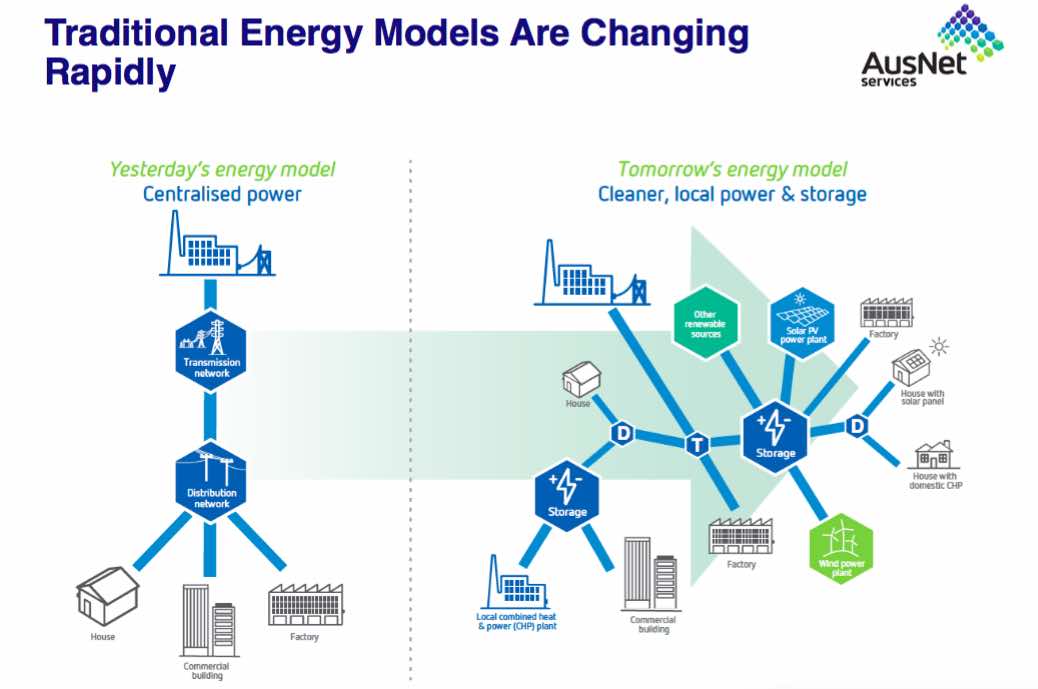Victoria-based network operator Ausnet predicts that nearly half of all electricity will be supplied by customers themselves, with solar and storage, heralding a dramatic shift from centralised fossil fuel generation to a cheaper and cleaner decentralised grid.
“By 2050, customers could supply up to 45 per cent of electricity, and electric vehicle uptake could increase significantly,” managing director Nino Ficca told an analysts briefing after the release of the company’s interim results on Wednesday.
Ficca noted that rising electricity bills and decreasing technology costs would drive the change to a consumer-based energy revolution. As the cost of grid-sources power continues to rise, and the cost of solar and storage continue to fall, customers would inevitably turn to their own means.
Ficca’s comments should not be seen as that much a surprise, given such observations have also been made by the likes of the CSIRO, the network operators peak body, the ENA, and other companies such as Engie.
“The role of customers and the energy flows on their network will change …. (and ) we are conscious that customers really want to see innovation and different ways of supplying energy,” Ficca told the briefing.
“The traditional reliance on heavy infrastructure may or may not be always the right answer. We must adapt and embrace change to be successful. We continue to transition to a modern energy future.”
Quite how that modern energy future evolves – and how the incumbent utilities, be they networks, generators or retailers – can adjust their business models to suit remains to be seen.
And Ficca hinted at the regulatory battles ahead as networks and gen-tailers fought for the ability to address the consumer market directly, and argued who should bear the responsibility of the increase in consumer bills.
Ausnet also spoke of the opportunities in large-scale wind and solar, with centralised generation evolving rapidly from those based around coal and gas, to a heavy renewable focused grid. It has previously forecast a renewables-dominated grid.
And while the Energy Security Board, is indicating only a modest uptake of wind and solar over the coming decade, Ficca said that Australia needed around 50GW of new capacity, regardless of the National Energy Guarantee, to replace the coal generators due to retire by 2030.
“The Australian Energy Market Operator forecasts that around 60 per cent of the existing coal generation fleet will retire by 2036,” Ficca said.
“Australia will need to connect up to 50 gigawatts of new large scale wind and solar generation before 2036, irrespective of the National Energy Guarantee.”
The greatest short-term opportunities are in its home base, Victoria, where the state government has legislated a 40 per cent renewable energy target for 2025, which will require around 5000MW of new wind and solar capacity.
The details of an auction for 650MW of new capacity – the largest to be held so far in Australia – was unveiled this week, with winners to be announced next July and construction to be completed by 2020.
Ausnet says there will be big opportunities to strengthen the grid, particularly in western Victoria where much of the wind and solar is expected to be installed, and where AEMO is looking to see whether new investment is needed to support some 3000MW of new capacity.
“The system strength in Western Victoria is low,” said Alistair Parker, Ausnet’s head of regulated energy services.
“This limits the amount of non-synchronous generation like new wind and solar that can be connected into that network … without more investment to improve system strength, it’s likely the new renewable generation would be constrained. ”
Parker says between $130 million and $780 million may need to be spent to boost the grid in Western Victoria alone. “That depends of course on the amount and location of the connecting generation.”
Parker said the NEG could potentially work, if it gets the support of the states. “The important caveat here is there’s limited policy detail at this stage and that detail will be absolutely critical to the policy success in terms of driving investment outcomes.”









